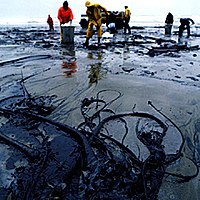
Photo from wikipedia
Quantifying the impacts of disturbances such as oil spills on marine species can be challenging. Natural environmental variability, human responses to the disturbance (e.g., fisheries closures), the complex life histories… Click to show full abstract
Quantifying the impacts of disturbances such as oil spills on marine species can be challenging. Natural environmental variability, human responses to the disturbance (e.g., fisheries closures), the complex life histories of the species being monitored, and limited pre-spill data can make detection of effects of oil spills difficult. Using long-term monitoring data from the state of Louisiana (USA), we applied novel spatiotemporal approaches to identify anomalies in species occurrence and catch rates. We included covariates (salinity, temperature, turbidity) to help isolate unusual events. While some species showed evidence of unlikely temporal anomalies in occurrence or catch rates, we found that the majority of the observed anomalies were also before the Deepwater Horizon event. Several species-gear combinations suggested upticks in the spatial variability immediately following the spill, but most species indicated no trend. Across species-gear combinations, there was no clear evidence for synchronous or asynchronous responses in occurrence or catch rates across sites following the spill. Our results are in general agreement to other analyses of monitoring data that detected small impacts, but in contrast to recent results from ecological modeling that showed much larger effects of the oil spill on fish and shellfish.
Journal Title: Environmental Monitoring and Assessment
Year Published: 2018
Link to full text (if available)
Share on Social Media: Sign Up to like & get
recommendations!